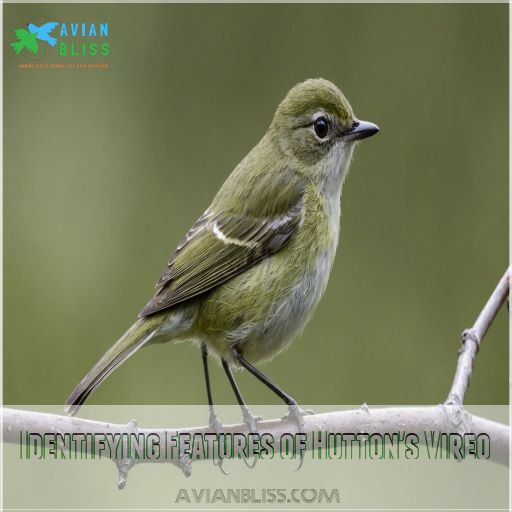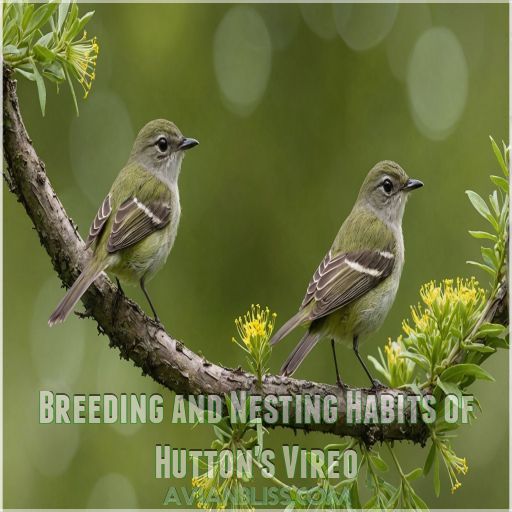This site is supported by our readers. We may earn a commission, at no cost to you, if you purchase through links.

Sporting two white wing-bars and a distinctive broken eye-ring, it’s often busy foraging high up in oaks and pines. Its call? A repetitive, single-note song that sounds like a broken record.
Found mostly along the Pacific Coast, it’s a homebody except when food runs low. The Hutton’s Vireo plays a key role in insect control, earning it a spot as nature’s own pest manager.
Want more bird insights? Just keep going.
Table Of Contents
- Key Takeaways
- Identifying Features of Hutton’s Vireo
- Habitat and Range of Hutton’s Vireo
- Hutton’s Vireo Diet and Foraging Behavior
- Breeding and Nesting Habits of Hutton’s Vireo
- Vocalizations and Communication of Hutton’s Vireo
- Conservation Status and Population Trends
- Hutton’s Vireo Interactions With Other Species
- Frequently Asked Questions (FAQs)
- What does a Hutton’s vireo look like?
- Where do Hutton’s vireos live?
- Is the population of Hutton’s vireo stable?
- What do Hutton’s vireo eat?
- How do you identify a Hutton’s vireo?
- What is the difference between Hutton’s vireo and Cassin’s vireo?
- What is the difference between a Huttons vireo and a ruby crowned kinglet?
- How do Huttons Vireos adapt to urban environments?
- What are the predators of Huttons Vireos?
- How do climate changes affect Huttons Vireo migration?
- What is the lifespan of a Huttons Vireo?
- How do Huttons Vireos deal with diseases?
- Conclusion
Key Takeaways
- Keen Eye Required: You might mistake Hutton’s Vireo for a Ruby-crowned Kinglet, but pay attention—Hutton’s moves more deliberately and sports an olive-green plumage with two white wing bars. It’s like playing a game of "spot the difference" in the trees!
- Homebodies of the West Coast: These birds are mostly homebodies, sticking to oak and pine-oak forests along the Pacific Coast. They’re the kind of neighbors who love their turf and aren’t big travelers; they only wander when food runs low.
- Nature’s Pest Controllers: Hutton’s Vireo plays a crucial role in controlling insect populations. Imagine them as tiny feathered heroes keeping the bug world in check with their acrobatic hunting strategies, from hovering like mini-helicopters to hanging upside down for a snack.
- Love Among the Trees: When it’s time to mate, males serenade with a repetitive, single-note song. These lovebirds are diligent nest builders, crafting camouflage nests from bark, lichens, and spider webs. Talk about a DIY home sweet home!
Identifying Features of Hutton’s Vireo
You’ll need a keen eye to spot the Hutton’s Vireo.
This tiny songbird often plays hide-and-seek in the foliage.
This compact charmer, measuring just 4 1/4 to 4 3/4 inches long, boasts a unique mix of features that’ll help you tell it apart from its look-alike cousins.
It has several distinct characteristics.
Physical Appearance and Size
Imagine a feathered Lilliputian flitting through the trees – that’s your Hutton’s Vireo! This pint-sized songbird packs a punch in its tiny frame.
Here’s what you’ll spot:
- A compact body measuring just 4-5 inches long
- Chunky build with a large head and short bill
- Wingspan ranging from 7.5-8.3 inches
Don’t let its size fool you – this little bird’s got a big personality! You’ll often see them foraging in pairs, even outside breeding season.
Distinctive Coloration and Markings
You’ll love spotting the Hutton’s Vireo’s unique features. Its olive-green plumage is a sight to behold, but it’s the details that’ll make your heart sing.
Look for two white wing-bars with a dark gray patch between them – it’s like nature’s own fashion statement.
Don’t miss the broken white eye-ring and pale lores, giving this little charmer a wide-eyed, innocent look that’ll melt your heart.
Comparison With Similar Species
While Hutton’s Vireo might play a game of "spot the difference" with its lookalikes, you can become a pro at telling them apart. Here’s how to distinguish this tiny songbird from its doppelgängers:
- Cassin’s Vireo: Hutton’s has a duller olive-gray head, not as bold "spectacles"
- Bell’s Vireo: Hutton’s sports a chunkier build and thicker bill
- Ruby-crowned Kinglet: Hutton’s moves more deliberately, lacks the kinglet’s constant wing-flicking
Remember, practice makes perfect in this avian identity parade!
Unique Behavioral Traits for Identification
Spot a Hutton’s Vireo by its quirky wing-flicking habit, reminiscent of a Ruby-crowned Kinglet’s dance (Source).
You’ll notice its slow, deliberate foraging style as it hops from twig to twig, often hovering briefly to snatch insects.
Listen for its monotonous song, a single note repeated like a broken record.
Unlike its hyperactive kinglet lookalike, this little green bird moves with the grace of a tiny, feathered sloth .
Habitat and Range of Hutton’s Vireo
You’ll find Hutton’s Vireos hanging out in oak woodlands and pine-oak forests along the Pacific Coast and Southwest regions.
These tiny songbirds are mostly homebodies, sticking around year-round, but some venture to lowland streams when the weather turns chilly, especially during the Pacific Coast.
Preferred Ecosystems and Vegetation Types
Now that you’ve got your eye on this pint-sized charmer, let’s explore where Hutton’s Vireos hang their hats.
These feathered homebodies are real forest foodies, with a menu that’d make any tree-hugger drool:
- Oak woodlands: Their go-to spot for a cozy nest
- Coniferous forests: Redwoods and firs? Yes, please!
- Mixed habitats: They’re not picky, as long as it’s green
- Chaparral: Sometimes they rough it in the scrub
Talk about adaptable neighbors!
Geographic Distribution Across North America
You’ll find Hutton’s Vireos strutting their stuff across a wide swath of North America.
These little songbirds have made themselves at home from British Columbia to Guatemala, with a particular fondness for the Pacific Coast and Southwest.
They’re not picky about altitude either, happily setting up shop from seaside forests to lofty mountains over 11,800 feet high.
Talk about adaptable neighbors!
Seasonal Migration Patterns
Most Hutton’s Vireos are homebodies, bucking the trend of their migratory cousins. These little rebels of the bird world stick to their territories year-round, embodying the phrase "home sweet home" (Source).
While they’re not jet-setters, their seasonal patterns still hold some surprises.
- Some coastal birds may wander to lowland streams in winter
- Elevation shifts occur in mountainous regions
- Pairs often join mixed-species flocks during colder months
- Food availability influences local movements
- Occasional "vagrants" venture beyond typical ranges, keeping birders on their toes
Adaptations to Specific Habitats
While Hutton’s Vireos don’t migrate, they’ve mastered the art of adapting to various habitats.
These little songbirds are the ultimate homebodies, thriving in coniferous and oak forests from coastal areas to arid mountains. They’re not just surviving; they’re thriving!
Check out how these clever birds have adjusted their lifestyles to different environments:
| Habitat | Nest Placement | Foraging Strategy |
|---|---|---|
| Coastal | Higher in trees | Methodical insect hunting |
| Inland | Lower, 7-25 ft | Fruit and gall foraging |
| Riparian | Near water | Hover-gleaning |
Hutton’s Vireo Diet and Foraging Behavior
You’ll be amazed by the Hutton’s Vireo’s acrobatic foraging skills as it hops and hovers through trees, snatching insects mid-air.
This tiny foodie’s menu features a smorgasbord of bugs, with some berries and plant galls thrown in for good measure.
Primary Food Sources and Preferences
On the menu for Hutton’s Vireo: a smorgasbord of insects and berries.
These tiny songbirds have a big appetite for caterpillars, beetles, and crickets that might seem too large for their small size. They’re not picky eaters, though – they’ll also snack on spiders, berries, and even plant galls.
Talk about a diverse diet! Their food preferences change with the seasons, adapting to what’s available in their oak and pine-oak forest homes, where they can find an abundance of insects and berries and other food sources, allowing them to have a diverse diet.
Foraging Techniques and Strategies
You’d be amazed at how these tiny birds hunt their meals!
Hutton’s Vireos are master foragers, using a mix of clever techniques to snag their insect prey. They’ll methodically search tree foliage, often high up, and investigate branch tips with eagle-eyed precision.
Here are three fascinating foraging strategies that’ll make you root for these resourceful birds:
- Hovering like mini-helicopters to pluck insects from leaves
- Hanging upside-down to reach hidden snacks
- Chasing flying bugs mid-air for an acrobatic snack
Seasonal Variations in Diet
The Hutton’s Vireo’s menu changes with the seasons, like a tiny gourmet adapting to nature’s buffet.
In winter, when insects play hard-to-get, these resourceful birds switch gears, similar to how the plumbeous vireo adjusts its diet to rely more on Plumbeous Vireo Winter Fruits. They’ll snack on berries and even slurp up sap from sapsucker wells.
Come spring, it’s back to bug-hunting, with caterpillars, beetles, and crickets on the menu, making them primarily insect-eaters like the plumbeous vireo which eats insects including caterpillars, beetles, and wasps.
Talk about a flexible diet plan!
Role in Local Ecosystems
As seasons change, so does the Hutton’s Vireo’s impact on its ecosystem.
You’ll find these tiny songbirds playing a key role in insect control, acting like nature’s own pest management team, similar to the foraging habits of conifer-dwelling birds
.
They’re not just bug-busters though – these little foragers also help with seed dispersal, giving Mother Nature a hand in habitat restoration.
It’s like they’re the unsung heroes of food web dynamics, keeping things balanced one bite at a time!
Breeding and Nesting Habits of Hutton’s Vireo
You’re in for a treat as we explore the intimate world of Hutton’s Vireo nesting habits.
These tiny architects craft cup-shaped nests suspended from forked branches.
They work together as couples to build cozy homes for their future chicks, a true example of working together.
Mating Rituals and Pair Formation
Imagine a tiny Romeo serenading his Juliet – that’s the Hutton’s Vireo during breeding season!
These lovebirds take courtship seriously, with males singing their hearts out to defend their territory and woo potential mates.
When he’s ready to seal the deal, he’ll fluff up like a feathered peacock, spread his tail, and whisper sweet nothings (or rather, whine) to his chosen lady.
Talk about a birdie bachelor! The male’s display of affection is quite the spectacle, showcasing his unique style of whisper sweet nothings.
Nest Construction and Placement
Once lovebirds pair up, it’s time to build their cozy home.
You’ll find Hutton’s Vireo nests tucked away in oak or conifer trees, usually 6-25 feet off the ground.
These tiny architects weave a round cup using bark fibers, lichens, and moss, held together with spiderwebs.
They’re masters of camouflage, covering the outside with whitish plant down and spider egg cases.
Talk about a DIY home security system!
Egg-laying and Incubation Period
The Hutton’s Vireo’s family planning is a real egg-citing affair! You’ll find these tiny architects laying 3-5 white eggs with brown speckles.
Talk about a full house!
Both parents share incubation duties for 14-16 days, taking turns warming their precious cargo. It’s like a feathered tag team, ensuring their little ones get the best start in life.
Who knew such a small bird could be such a dedicated parent?
Parental Care and Fledgling Development
Devoted parents, Hutton’s Vireos are the epitome of teamwork when it comes to raising their young.
You’ll find both mom and dad tirelessly feeding their nestlings for about two weeks.
As the little ones grow, they’re treated to a smorgasbord of insects and spiders.
These tiny acrobats learn to fly at around 14 days old, but don’t be fooled – they’ll stick close to home for a while, perfecting their foraging skills under watchful parental eyes.
Vocalizations and Communication of Hutton’s Vireo
You’ll be surprised by the Hutton’s Vireo’s vocal repertoire, from its monotonous ‘zwee-zwee-zwee’ song to its array of calls and alarm sounds.
These tiny songbirds use their voices for everything from defending territory to wooing mates, with their vocalizations changing throughout the seasons.
Song Patterns and Variations
While you might think all Hutton’s Vireos sound the same, you’d be in for a surprise!
These tiny songbirds boast an impressive repertoire of tunes.
Their songs vary based on geographic location, habitat type, and even individual personality.
Like little feathered DJs, they mix up their playlist seasonally, adapting their melodies to different environments.
Next time you’re out birding, listen closely – you might just catch a unique Hutton’s Vireo remix!
Calls and Alarm Sounds
Beyond their melodious songs, Hutton’s Vireos have a secret language of calls and alarms.
You’ll be amazed by their vocal repertoire:
- Loud, short whistles that sound like "chu-whe" or "che-eer"
- Harsh "chit-chit" alarm calls when danger’s near
- Whining courtship calls to woo potential mates
- Frantic distress calls when protecting their nests
These tiny songbirds pack a punch with their voices, using them for everything from territorial defense to finding love.
Listen closely, and you’ll hear their world unfold.
Seasonal Changes in Vocalization
You’d be amazed how Hutton’s Vireo’s voice changes with the seasons.
During breeding season, these little songsters ramp up their vocal game, belting out complex tunes to defend their turf.
As winter approaches, they’ll tone it down a notch, trading their chatty summer anthems for softer whisper songs.
It’s like they’re playing nature’s own game of musical chairs, adapting their vocals to match the rhythm of the year.
Territorial and Mating-related Vocalizations
The Hutton’s vireo’s vocal repertoire is a veritable symphony of complexity.
You’ll be amazed by their intricate duet patterns, where mates harmonize in perfect sync.
These tiny songsters use their voices as weapons of territorial defense, belting out powerful mating calls that echo through the forest.
Their vocal mimicry skills are off the charts, too – they’re the karaoke kings of the bird world!
Conservation Status and Population Trends
When you think about the Hutton’s Vireo, you mightn’t worry about its numbers, since they’re fairly common with stable populations.
However, climate change and habitat changes are pulling a few tricks on them, so conservation efforts are as essential as ever to keep their cheerful melodies alive.
Current Population Estimates
While listening to Hutton’s Vireo’s enchanting songs, you might wonder about its population.
It’s heartening to know that this little songbird’s population trends are positive. With about 2.7 million globally, it hasn’t hit the endangered list yet.
Conservation success is promising, though habitat loss has its impact.
Future projections offer hope for continued harmony in their habitats.
Threats to Hutton’s Vireo Survival
Picture a small bird facing big challenges, much like those of the common backyard birds in Illinois bird species
.
Hutton’s Vireo survival is threatened by:
- Habitat loss from selective logging.
- Climate change, altering its delicate environment.
- Disease outbreaks, like sudden oak death caused by fungi.
- Invasive species disrupting its ecosystem.
Managing forests wisely safeguards these feathered friends in their oak sanctuaries.
Conservation Efforts and Protected Areas
Phew, you’ll be relieved to hear that Hutton’s Vireo populations are actually on the rise!
According to the Breeding Bird Survey, their numbers have increased by 1.3% per year since the 1960s.
That’s great news, but we can’t let our guard down. Preserving their forest habitats with lush understories is key to keeping these little guys thriving. (Source)
Impact of Climate Change on Population
Climate change is a curveball thrown at Hutton’s Vireo, subtly shifting population trends.
These tiny songbirds, though fairly common, face challenges like habitat loss.
You’re witnessing a race against time where conservation efforts aim to hold the line.
With wings twitching like nerves, their stable numbers need our support to brave this uncertain dance with nature.
Hutton’s Vireo Interactions With Other Species
You won’t believe how Hutton’s Vireo interacts with its neighbors in the wild.
From outsmarting predators to hanging out with chickadees and kinglets, it’s all about playing it cool and keeping a low profile.
Predators and Defense Mechanisms
You’ll find the Hutton’s Vireo has clever tactics for dodging dangers.
These tiny songbirds use camouflage and nimble moves to outsmart predators.
Their defenses include:
- Nesting high to avoid ground threats.
- Quick flights to confuse avian predators.
- Blending in with leafy surroundings.
- Staying silent when danger looms.
- Joining mixed-species flocks for safety in numbers.
Competitive Relationships With Similar Species
After dodging predators with flair, the Hutton’s Vireo faces a different kind of challenge—its competition with the Ruby-crowned Kinglet.
Both birds argue like siblings over food niches and prime nest sites.
Their foraging strategies even overlap, especially in winter flocking behavior, making these tiny, feathered rivals perform a fascinating dance of survival in shared habitats.
Symbiotic Relationships in Ecosystems
Hutton’s Vireo is more than just a pretty songbird; it’s a key player in maintaining ecological balance.
Imagine it in oak trees, curiously peering for insects.
These dynamics include:
- Vireo-Insect Interactions
- Mutualism with plant species
- Avian Parasitism involving cowbirds
- Predation and Mutualism with insects
- Predator-Prey Dynamics
It’s nature’s tiny operative!
Role in Mixed-species Foraging Flocks
Much like a social butterfly at a garden party, the Hutton’s Vireo thrives in mixed-species foraging flocks.
These merry bands boost foraging efficiency and reduce competition. You’ll enjoy seeing how they work together even without formal introductions!
| Aspect | Benefit to Hutton’s Vireo |
|---|---|
| Flock Composition | Diverse strategies |
| Foraging Strategy | Shared knowledge |
| Competition | Reduced pressure |
| Communication | Alert systems |
| Predation | Increased safety |
Frequently Asked Questions (FAQs)
What does a Hutton’s vireo look like?
Picture a small, greenish songbird with a chunky body, off-center eyering, and short wings.
You’ll find it flitting around oak and coniferous trees, often mistaken for a Ruby-crowned Kinglet due to its similar appearance.
Where do Hutton’s vireos live?
Imagine a small greenish bird weaving through oak and conifer forests along the Pacific Coast.
Hutton’s Vireos call these places home, from California to the mountains of Arizona.
These birds thrive in evergreen woodlands and mixed forests.
Is the population of Hutton’s vireo stable?
You’re in luck!
Hutton’s vireo populations are fairly common and stable, so you don’t need to lose sleep over their numbers, at least for now.
They’re like the solid neighbor who’s always around.
What do Hutton’s vireo eat?
Hutton’s Vireo munches on insects like caterpillars, beetles, and spiders, picking them right off leaves and branches.
They also nibble on berries and sap from sapsucker wells, balancing their diet with a fruity twist.
How do you identify a Hutton’s vireo?
As quick as a wink, you can spot a Hutton’s vireo by its thick, hooked bill and lack of eyering above the eye – a dead giveaway compared to the similar Ruby-crowned kinglet.
Keep your eyes peeled in oak and pine forests.
What is the difference between Hutton’s vireo and Cassin’s vireo?
Hutton’s Vireo and Cassin’s Vireo differ mainly in their songs and calls.
Hutton’s has a slower song, while Cassin’s song features an intermediate series of phrases, often flicking its wings nervously during singing.
What is the difference between a Huttons vireo and a ruby crowned kinglet?
Spot a Hutton’s Vireo by its chunky build and slow, deliberate moves, while the Ruby-crowned Kinglet flits nervously.
Check the bills—thicker and hooked on vireos, thin on kinglets—and their distinct wing patterns for easy identification, particularly noticing the distinct wing patterns.
How do Huttons Vireos adapt to urban environments?
Ever noticed how adaptable birds are?
Hutton’s Vireos thrive in urban areas by nesting in parks and yards, using local trees and shrubs for food and shelter.
Their constant chirping brings life to concrete jungles.
What are the predators of Huttons Vireos?
To protect Hutton’s Vireo nests, watch out for sneaky predators like jays, grackles, and squirrels.
They’ve got a knack for causing a fuss among vireos, who fiercely defend their home turf .
How do climate changes affect Huttons Vireo migration?
Climate change acts like a mischievous weatherman, muddling Hutton’s Vireo migration.
With changing monsoon timings and less precipitation, their usual haunts become unpredictable, affecting food availability.
This unpredictability forces these birds to adapt unpredictably.
What is the lifespan of a Huttons Vireo?
You might be surprised to learn Hutton’s Vireo can live up to 13 years in the wild.
They face challenges like habitat loss and brood parasitism, but these little birds are tougher than they look.
How do Huttons Vireos deal with diseases?
In a bygone era, these feathered friends have evolved clever ways to weather the storm.
By nestling in dense foliage and fortifying their immune systems, they deftly sidestep sudden oak death and other maladies.
Conclusion
So, you’ve made it through tales of Hutton’s Vireo, the little bird that could—if "could" means decimate insects with panache.
Armed with olive hues and a talent for pest control, this bird’s life’s a soap opera high in the oaks.
Feeling inspired to spot one? Remember, the broken-record call is your clue.
Embrace the quirks of Hutton’s Vireo, a fascinating feathered friend that proves good things indeed come in small, chirping packages, like those found in North Carolina’s forests, a variety of small birds in north carolina, that showcases the beauty of nature
.










